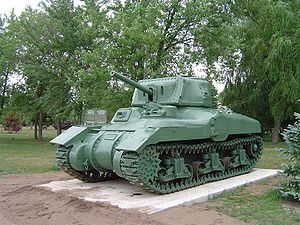Ram tank
| Tank, Cruiser, Ram | |
|---|---|

Early production Ram Mk II at CFB Borden
|
|
| Type | Medium tank |
| Place of origin | Canada |
| Service history | |
| Used by | Canada |
| Wars | Second World War |
| Production history | |
| Designed | 1941 |
| Manufacturer | Montreal Locomotive Works |
| Produced | 1941–43 |
| No. built | approx 2,000 |
| Specifications (Ram Mk II) | |
| Weight | 65,000 lb (29 t) |
| Length | 19 ft (5.8 m) |
| Width | 9 ft 10 in (3.00 m) |
| Height | 8 ft 9 in (2.67 m) |
| Crew | 5 (Commander, gunner, loader, driver, co-driver/hull gunner) |
|
|
|
| Armour | 25-87 mm |
|
Main
armament |
QF 6 pdr Mk III 92 rounds |
|
Secondary
armament |
3 × .30 in (7.62 mm) machineguns (Ram I 4,715 rounds, Ram II 4,440 rounds.) |
| Engine |
Continental R-975 9-cyl radial gasoline engine 400 (298 kW) |
| Power/weight | 12.3 hp/ton |
| Transmission | Borg-Warner clutch, controlled differential |
| Suspension | Vertical volute spring |
|
Operational
range |
232 km (144 mi) |
| Speed | 25 mph (40 km/h) |
The Tank, Cruiser, Ram was a cruiser tank designed and built by Canada in the Second World War, based on the U.S. M3 Medium tank. Due to standardization on the American Sherman tank for frontline units, it was used exclusively for training purposes and was never used in combat as a gun tank. The chassis was used for several other combat roles however, such as a flamethrower tank, observation post, and armoured personnel carrier.
Even before the loss of the majority of the United Kingdom's tank force in France in 1940 after Dunkirk, it was recognised that tank production in the UK at the start of the war was insufficient and capacity in the US was taken for British needs. So it was necessary that if Canada was to equip with tanks they would have to be manufactured locally. In June 1940 the Canadian Pacific Railway's Angus Shops in Montreal, as the only large firm with spare capacity, had received a contract to produce 300 partially fitted out Valentine tanks for the British; this was followed later with one for 488 complete tanks for Canada. However the Valentine was an infantry tank and Canada required a cruiser tank for its recently formed armoured division. In the end 1,420 Valentines were produced by CPR, most of which were supplied to the USSR. Although the Valentine used a number of American produced parts, its reliance on British components, difficulties in adapting its manufacture to North American methods, and other problems such as limitations to the availability of the right type of armour plate affected Valentine production. The Canadian Joint Committee on Tank Development concluded, in September 1940, that its cruiser tank should be based on a US rather than a British design. This would be quicker and allow it to use components already in production for the US design.
The Canadians were interested in production of the M3 Medium. However the M3 was an interim design; its main armament was in a side sponson, it was tall, and under-armoured, and it was clear that it would be unsatisfactory for Canadian and British use. In early 1941 the Canadian Interdepartmental Tank Committee adopted a compromise: to develop a superior design locally but still using the M3 chassis. The British Tank Mission which was involved in the modifications of the M3 for British use contributed a tank expert, L.E.Carr, to design a new hull and turret for the Canadian tank, which could take a 6-pounder (57 mm) or 75mm gun while retaining the lower hull of the US M3 Medium.
...
Wikipedia
